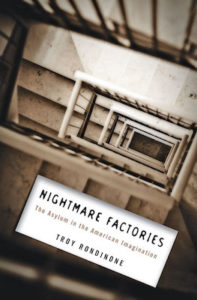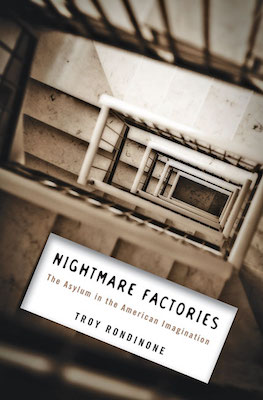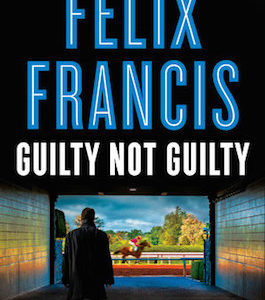Cold War paranoia kicked off on August 6, 1945, when a flash over Hiroshima signaled the end of a seven-year orgy of industrialized death and birthed a new, disturbing age. As poet Allen Ginsberg noted, “the splitting of the atom” brought about a “splitting of the old structures in society and also a sense of the inner world splitting up and coming apart.” Inspired by his own stay at a mental institution, Ginsberg would compose a legendary indictment of a world gone crazy with his poem, “Howl.” Here, he suggested that we lived in an “armed madhouse.”
The madhouse was an apropos Cold War era organizer. In the landmark 1951 novel The Catcher in the Rye by J. D. Salinger, young Holden Caulfield goes on a brief, bizarre trip to New York City after being expelled from yet another prep school. He encounters “phonies,” battles a pimp, agonizes over girls, and generally tries to get a hold of himself. Significantly, Caulfield narrates his adventures from the confines of a mental institution. He tells us, “If you really want to hear about it, the first thing you’ll probably want to know is where I was born, and what my lousy childhood was like, and how my parents were occupied and all before they had me, and all that David Copperfield kind of crap.” But he will skip the Freudian childhood ordeals and “just tell you about this madman stuff that happened to me around last Christmas before I got pretty run-down and had to come out here and take it easy.” Later, however, it’s clear that a childhood trauma, his brother’s death, has much to do with his disturbances. Salinger uses words like “crazy,” “mad,” “screwy,” and “complexes” to convey Holden’s state of mind, but, as one influential contemporary reviewer saw it, “It is not Holden who should be examined for a sickness of the mind, but the world in which he has sojourned and found himself an alien.”
The idea that we all belong in the booby hatch is, of course, no Cold War invention. But Holden’s saga spoke to a novel praxis of existential fears and Freudian expressions that saturated his America. In The Sane Society (1955), pop analyst Erich Fromm noted that civilization now faced “schizoid self-alienation.” Fromm was not alone in the opinion that society was ill. Misogynists like Philip Wylie pinned the etiology on “castrating” mothers. Martinet psychiatrists such as Fredric Wertham blamed the comic books. Sociologists like David Riesman and William H. Whyte argued Americans were more concerned with fitting in than with being independent. Hipper theorists like Paul Goodman posited that America warped youngsters by creating a “neurosis of chronic boredom” and “sexual paranoia.” It goes without saying that by showing us the walls of our new prison, these intellectuals could offer us the tools of escape.
During the Cold War, this dark vision made sense. Never had we been so affluent; never did the Apocalypse seem so imminent. Never had the asylum seemed such a suitable metaphor.
Film Noir
Perhaps no genre better reflected the new totalitarian encroachment than film noir. Roughly spanning between 1940 to 1960, this cinematic field reflected a culture living with new uncertainties and fears. Dark shadows, devious characters, femmes fatales, tormented heroes, and a subtext of violent sexuality all spoke to Fromm’s “schizoid self-alienation.” The audience was encouraged to empathize with transgressors and underworld denizens. The Freudian jargon that often pops up in these films is targeted to help the audience analyze and uncover evil plots.
Dark shadows, devious characters, femmes fatales, tormented heroes, and a subtext of violent sexuality all spoke to Fromm’s “schizoid self-alienation.”Noir suited the asylum and vice versa. In The Snake Pit, caged windows cast long, dark shadows on the walls, metaphorically confining Virginia Cunningham as she knits her brows and awaits her shock treatment. In Spellbound, Shock, and Strange Illusion, private sanitariums are settings for malign plots and twisted psychiatrists. In these movies, the old “dungeon” asylum is replaced by a more formal space in which analysts lounge in book-lined offices and monitor patients with the help of uniformed attendants and nurses. The gothic style is still here; secrecy, torture, and control lurk not far beneath the surface. Yet innovations complicate things. In Strange Illusion, for instance, technological surveillance is evident in its one-way mirror room, embodying Foucault’s notion of the “internalized gaze” of the panopticon. In Spellbound, a heroic female analyst helps Gregory Peck recover lost memories and free himself, even as a bad shrink tries to destroy him. Mingling good and bad, dark and light, is a noir specialty. I’ll examine two films, High Wall (1947) and Screaming Mimi (1958), to illustrate this.
In High Wall, a World War II veteran named Steven Kenet, suffering from a combat-related head injury, returns home to find himself accused of murdering his wife. He confesses but, when the police doctor recognizes he is mentally deranged, he is sent to the Hamelin County Psychiatric Hospital. Suitably introduced at night and surrounded by the eponymous high wall, we learn that Kenet has a “subdural hematoma of the left frontal lobe” that has caused “both physical and emotional changes.” He’s put in a small cell with a lone mattress on the floor, grated windows, and a small, barred door portal. Like some other Freudian asylums, this place has a saving grace in the form of a gentle and assuring doctor. The beautiful Dr. Anne Lorrison helps him, through narco-synthesis, discover that he has been framed. Kenet breaks out and, with the help of Dr. Lorrison (who falls for him), finds out that the real murderer is his wife’s boss with whom she’d been having an affair. With more narco-synthesis, Kenet gets the man to confess. The film’s asylum locale and strained Sodium Pentothal-based plot did not pass muster with the New York Times, whose critic called it “morbid and socially cynical” before concluding it was “Just the thing for your holiday entertainment—unless, of course, you are sane.”
War experience informs High Wall. Kenet served and married a woman while on leave; their child is an almost entirely unknown creature to him. His wife covets his high rank and commensurate pay, and, after the war, she doesn’t want him to take a pay cut at the university, even though that’s where he wants to work. So he must continue flying in Burma, which still results in a salary loss. This forces his wife to get a secretarial job, exiling her from the domestic ideal, and here she has an affair with her boss. Although Kenet is a war hero (he has a Distinguished Service Cross and a Silver Star), he cannot navigate postwar life, his wife and his brain trauma conspiring to send him to the asylum. Director Robert Taylor would later say that with this film, “I suddenly saw a chance to bring directly to the American people the experience of the war. In the American pictures, this experience is treated as a kind of ballyhoo concept. The Best Years of Our Lives came after High Wall.”
Just as with Spellbound and The Snake Pit, a kindly analyst using the latest techniques serves as redeemer in High Wall. With Sodium Pentothal, at the time commonly depicted as a wonder drug, Kenet discovers that he did not really murder his wife. The administration of the drug and the sleep-like state induced is realistically shown, though the plot-resolving flashbacks are smirk inducing. Dr. Lorrison also helps him by diagnosing his desperate need to “escape from reality,” and her kindness effectively neutralizes the depressing situation of hospital life. Lorrison provides a proper postwar model of feminine, domestic support, juxtaposing Kenet’s own viperous one, and literally becoming a mother to his otherwise orphanage-bound son. She supports Kenet and helps solve the crime.
High Wall uses film noir language to modernize the asylum. Wrapped in shadows and rainy nights, the narrative takes us along with a troubled war hero to unmask a duplicitous plot that emasculates and quarantines him. We wind up rooting for an asylum escapee, committed on false pretenses but who nonetheless receives treatment from a doctor who is both professional and domestic. In sum, this film contains plenty of paradoxes. The asylum is frightening but redeeming, it’s understaffed but has caring staff, and the asylum doctor turns out to be the polar opposite of the hero’s scheming wife. In High Wall, a noir sensibility captures the fears of postwar assimilation and provides a happy ending to a veteran’s nightmare.
A more bizarre example of the noir asylum is Fredric Brown’s pulp, The Screaming Mimi. Published in abbreviated form in Mystery Book Magazine in October 1949 and then by E. P. Dutton as a novel, the story relates the adventures of a boozy, down-and-out reporter named William Sweeney. We begin on a summer night with Sweeney chugging his way through a bender on a park bench in Bughouse Square, a place “bright with lights, but dark with the shadows of the defeated men who sit on the benches.” On Sweeney’s way home, he encounters a beautiful woman in a white gown sprawled in the doorway of an apartment building, guarded by a large dog. As she slowly rises, it’s apparent that she has been seriously injured, a large red slash on her abdomen. The police arrive but are kept at bay by the fearsome dog. Then “the incredible thing happened.” The dog gets up on his hind legs and, with his teeth, unzips the gown. The dress drops, and the woman now stands completely naked. A cop shoots the dog and the woman is taken off in an ambulance. The dog, who turns out to be both the woman’s protector and stage-prop for her stripping act, survives.
We learn that there have been a series of murders in the city, and this waif, Yolanda, appears to be the only surviving victim of the killer. But nothing is as it seems. Yolanda not only sets the story in motion, but she also turns out to be the killer herself. Through a series of discoveries that rely on Freudian interpretations of past traumas, we see that as a youth she was attacked by a knife-wielding, asylum escapee. She had a breakdown and was institutionalized. Her psychiatrist fell in love with her and helped get her out, quitting his job to become her manager. Yolanda, née Bessie Wilson a quiet girl from Wisconsin, became a vivacious Chicago stripper. Her new personality “splits” again when she turns into The Ripper, who performs a ritual of “transference” using a horrible, little statue called “The Screaming Mimi.”
The madhouse motif carries through the novel. We open at Bughouse Square. The femme fatale works at a strip club named El Madhouse. She is an unwell, asylum patient, sent there in the first place by an escapee. Her ex-asylum doctor runs her degraded life. The Woman in White here is both victim and killer, an appropriate example of noir’s wiggling of moral expectations.
The book inspired two films, the first being 1958’s Screaming Mimi starring Swedish bombshell Anita Ekberg. The film differs a bit from the book, lingering on Ekberg’s sultry S&M-style stage act and the unique screen presence of famed burlesque queen Gypsy Rose Lee (playing a predatory lesbian dominatrix). The film also plays up the bad shrink role of Dr. Greenwood (as the movie calls him), who is shown closely monitoring Virginia (as Bessie is renamed) in a cell-like room in the Highland Sanitarium. He is a classic Svengali, his power gleaned from controlling an unattainable beauty, he, at one point, actually says to her, “You must do as I say!” The film ends with Virginia, draped in a white overcoat, getting taken to the asylum in a wagon by uniformed attendants. The movie was too much, or just too odd, for the late-fifties audience (and for Brown himself). It was yanked after a short run as part of a Columbia double feature.
Other film noirs similarly used asylums to plunge audiences into paranoid environments. Shock (1946) matches scenes of madness with a stormy night, lightning illuminating the asylum. Shock also combines a femme fatale with a Woman in White in Elaine, coldly captivating in her starch white nurse’s dress. Vincent Price’s Dr. Cross winds up a kind of murderous Tom Rath, until, at the very end, he refuses to kill his patient and strangles Elaine instead. Kiss Me Deadly (1955), based on Mickey Spillane’s book of almost the same title (he has a comma after Me), starts at night on a desolate road with a blond in a pale trench coat fleeing an asylum. Mike Hammer takes her in, his sense of honor overpowering his jaded, narcissistic personality. We eventually discover that this Woman in White was sent to the “funny farm” as a means of extracting information about a key to a locker containing (in the film but not the book) a suitcase of nuclear materials. In The Enforcer (1951), Humphrey Bogart talks to a patient in a wet pack in the “State Hospital for the Insane,” musing, “The lunatic’s the only one who makes sense.” In Possessed (1947), Joan Crawford goes to a “Psychopathic Dept” in a hospital and is thrust into a room that resembles a cell. A doctor laments, “This civilization of ours is a worse disease than heart trouble or tuberculosis and we can’t escape it.” Luckily for Crawford, a good Freudian doctor brings her back to sanity. Then there are bad, femme fatale shrinks in films like Nightmare Alley (1947), Ring of Fear (1954), and Shock Treatment (1964). These temptresses wield analysis like a knife.



















